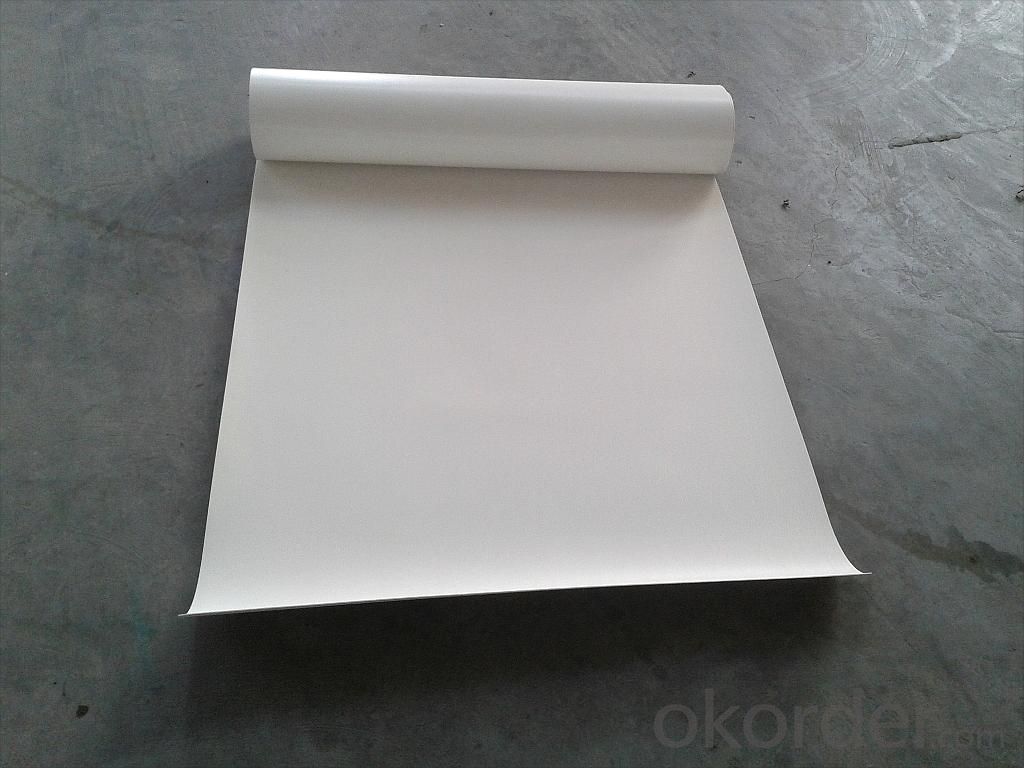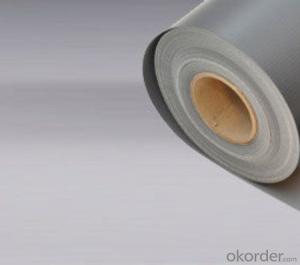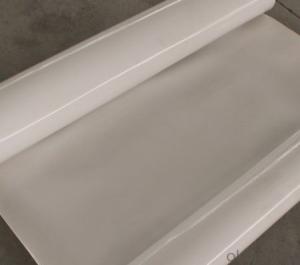TPO Membrane glaze for Waterproof System
- Loading Port:
- Qingdao
- Payment Terms:
- TT OR LC
- Min Order Qty:
- 13000 m²
- Supply Capability:
- 100000 m²/month
OKorder Service Pledge
OKorder Financial Service
You Might Also Like
TPO Membrane glaze for Waterproof System
Description Of TPO Membrane glaze for Waterproof System
1.TPO Membrane glaze is made from Thermoplastic polyethylene hydrocarbons , which is for waterproofing of exposed and non-exposed applications.
2. TPO Membrane glaze adopts the world-advanced equipment of cold feeding extrusion and continuous vulcanization technology.
3. TPO Membrane glaze is of high elasticity among high polymer waterproof materials and becomes a world-popular waterproofing material.
Main Features of TPO Membrane glaze for Waterproof System
1. Excellent physical and mechanical performance
2. High tearing resistance
3. Good deformation adaptability
Specifications of TPO Membrane glaze for Waterproof System
Material | Thermoplastic polyethylene hydrocarbons |
Size | 1.2m (width)*20m (length) or customized, weldable type 2.05m |
Thick | 1.2mm, 1.5mm, |
Applications of TPO Membrane glaze for Waterproof System
1.Roofs, Basement
2. Industrial and civil building waterproofing
3. Geosynthetic liner for swimming pool, channels, irrigation system
IMages of TPO Membrane glaze for Waterproof System


FAQ:
1. What are we supplying?
We are specialized in producing Colorful Asphalt Roof Shingle, SBS/APP modified bitumen waterproof membrane, Self adhesive bitumen waterproof membrane, PVC waterproofing membrane,Single Component Polyurethane Waterproof Coating, and Spray Polyurea Waterproof Coating
.
2. How Many years experience do we have?
We have been exported to more than 15 countries in the past 14years.
3. How long do we usually reply your request?
We always reply our customer within 4 hours.
- Q:Are there any limitations to using a waterproofing membrane?
- Yes, there are some limitations to using a waterproofing membrane. One limitation is that the membrane can be punctured or damaged during installation, which can compromise its effectiveness. Additionally, waterproofing membranes may not be suitable for all types of surfaces or structures, and certain conditions such as extreme temperatures or excessive movement can affect their performance. Moreover, the lifespan of a waterproofing membrane can vary depending on factors like maintenance, exposure to UV rays, and overall wear and tear.
- Q:Is a waterproofing membrane environmentally friendly?
- Yes, a waterproofing membrane can be considered environmentally friendly. Waterproofing membranes are designed to prevent water leakage and damage to structures, which can contribute to the longevity of a building and reduce the need for repairs or replacements. This can result in a reduction in construction waste and the overall environmental impact of the building industry. Furthermore, some waterproofing membranes are made from eco-friendly materials, such as recycled content or bio-based materials, which can help reduce the carbon footprint associated with their production. Additionally, these membranes can be designed to be recyclable or biodegradable, further reducing their environmental impact at the end of their life cycle. Moreover, by preventing water infiltration, waterproofing membranes can help protect the structural integrity of buildings, preventing moisture-related issues such as mold growth and rot. This can contribute to maintaining a healthy indoor environment and reducing the need for energy-intensive remediation measures. It is important, however, to consider the specific characteristics and certifications of a waterproofing membrane to assess its environmental friendliness accurately. Look for certifications such as LEED (Leadership in Energy and Environmental Design) or products that have undergone life cycle assessments to ensure that they meet rigorous environmental standards. In summary, while not all waterproofing membranes may be inherently environmentally friendly, the use of certain materials and the prevention of water damage can make them a sustainable choice for building projects.
- Q:Can a waterproofing membrane be used for parking structures or garages?
- Parking structures or garages can benefit from the use of a waterproofing membrane. Due to their exposure to harsh weather conditions, these structures are susceptible to water damage. To counter this, a waterproofing membrane acts as a protective barrier, preventing water from seeping into the concrete or other materials. By doing so, it effectively prevents issues like corrosion, cracking, and deterioration. Moreover, it also offers protection against elements such as chemicals, oils, and salts commonly found in parking areas. Therefore, it is highly advisable to incorporate a waterproofing membrane to enhance the longevity and durability of parking structures and garages.
- Q:Can a waterproofing membrane be used in renovation or retrofitting projects?
- Yes, a waterproofing membrane can definitely be used in renovation or retrofitting projects. In fact, it is often a critical component in such projects to ensure the long-term durability and protection of the building or structure. Waterproofing membranes are designed to create a barrier against moisture infiltration, preventing water damage, mold growth, and structural deterioration. During renovation or retrofitting, it is common to encounter issues like leaks, cracks, or deteriorated building materials that compromise the building's waterproofing system. In such cases, applying a waterproofing membrane over the affected areas can effectively seal and protect them from further damage. This can be done both on the interior and exterior of the building, depending on the specific requirements. Waterproofing membranes come in various forms, such as sheet membranes, liquid coatings, or spray-applied membranes. They can be applied to different surfaces like roofs, walls, basements, or even foundations. These membranes are flexible, durable, and resistant to water and other environmental stresses, making them ideal for renovation or retrofitting projects where there is a need to enhance the building's waterproofing capabilities. In conclusion, incorporating a waterproofing membrane in renovation or retrofitting projects is highly recommended to ensure the longevity and integrity of the building. It serves as a proactive measure to prevent future water damage, maintain structural stability, and improve the overall quality of the renovated or retrofitted space.
- Q:Can a waterproofing membrane be used in residential buildings?
- Absolutely, residential buildings can indeed utilize a waterproofing membrane. In fact, it is highly advisable due to its ability to effectively block moisture, thus preventing any water-related harm or growth of mold. Areas in residential buildings that are prone to water exposure, such as basements, bathrooms, roofs, and balconies, commonly employ waterproofing membranes. These membranes are typically applied on either the exterior or interior surfaces, creating a protective layer that hinders water infiltration. Consequently, this aids in preserving the building's structural integrity, prolonging its lifespan, and augmenting the overall comfort and safety of its inhabitants. Therefore, incorporating a waterproofing membrane into residential buildings is a prudent investment for safeguarding against potential water-related complications.
- Q:Can a waterproofing membrane be exposed to sunlight?
- Certainly, sunlight poses no problem for a waterproofing membrane. In reality, numerous waterproofing membranes are engineered to endure extended exposure to sunlight without any degradation or loss of efficacy. Nevertheless, it is vital to acknowledge that not all waterproofing membranes possess equal resistance to UV rays, hence it is crucial to select a membrane explicitly designed for outdoor applications and capable of withstanding sunlight exposure. Furthermore, it is always advisable to adhere to the manufacturer's instructions and guidelines pertaining to the particular waterproofing membrane being utilized, in order to guarantee its longevity and optimal performance.
- Q:Can a waterproofing membrane be used for sealing pipe penetrations?
- Yes, a waterproofing membrane can be used for sealing pipe penetrations. Waterproofing membranes are designed to create a barrier against water and moisture, making them suitable for sealing pipe penetrations to prevent water leakage or intrusion.
- Q:Can a waterproofing membrane be used on hollow core block surfaces?
- Indeed, the utilization of a waterproofing membrane is possible on hollow core block surfaces. Waterproofing membranes are a widely employed measure to safeguard various surfaces against water infiltration and subsequent harm, encompassing surfaces composed of concrete and masonry. Hollow core block surfaces, being constructed from concrete, are not an exception to this practice. The application of a waterproofing membrane onto the exterior of hollow core blocks can effectively shield them from water intrusion and potential damage caused by moisture. This becomes particularly crucial in regions where exposure to water is frequent, such as basements or subterranean structures. However, it is of utmost importance to ensure that the specific waterproofing membrane chosen is compatible with hollow core block surfaces and that proper installation techniques are adhered to in order to attain optimal outcomes and long-lasting protection.
- Q:Can a waterproofing membrane be used for a parking garage deck?
- Yes, a waterproofing membrane can be used for a parking garage deck. Waterproofing membranes are commonly used in parking garages to protect the concrete structure from water damage caused by rain, snow, and other environmental factors. These membranes create a barrier that prevents water from penetrating the deck, helping to extend its lifespan and reduce maintenance costs.
- Q:Can a waterproofing membrane improve energy efficiency?
- Yes, a waterproofing membrane can improve energy efficiency. A waterproofing membrane acts as a barrier against moisture intrusion, preventing water from seeping into the building envelope. By keeping the structure dry, it helps to prevent the growth of mold and mildew, which can contribute to poor indoor air quality and the deterioration of building materials. In addition to protecting against moisture, a waterproofing membrane can also provide insulation benefits. Many waterproofing membranes are designed to have a high thermal resistance, or R-value. This means that they can provide an extra layer of insulation to the building, reducing heat transfer through the walls or roof. By improving the building's thermal performance, a waterproofing membrane can help to reduce the load on heating and cooling systems, resulting in energy savings and improved energy efficiency. Furthermore, a waterproofing membrane can also help to reduce air leakage in a building. Air leakage can account for a significant amount of energy loss, as conditioned air escapes through gaps and cracks in the building envelope. By sealing off these areas, a waterproofing membrane can help to improve the building's air tightness, reducing energy loss and improving energy efficiency. Overall, a waterproofing membrane can play a crucial role in improving energy efficiency by preventing moisture intrusion, providing additional insulation, and reducing air leakage. Investing in a high-quality waterproofing system can lead to long-term energy savings, improved indoor comfort, and a more sustainable and efficient building.
1. Manufacturer Overview |
|
|---|---|
| Location | |
| Year Established | |
| Annual Output Value | |
| Main Markets | |
| Company Certifications | |
2. Manufacturer Certificates |
|
|---|---|
| a) Certification Name | |
| Range | |
| Reference | |
| Validity Period | |
3. Manufacturer Capability |
|
|---|---|
| a)Trade Capacity | |
| Nearest Port | |
| Export Percentage | |
| No.of Employees in Trade Department | |
| Language Spoken: | |
| b)Factory Information | |
| Factory Size: | |
| No. of Production Lines | |
| Contract Manufacturing | |
| Product Price Range | |
Send your message to us
TPO Membrane glaze for Waterproof System
- Loading Port:
- Qingdao
- Payment Terms:
- TT OR LC
- Min Order Qty:
- 13000 m²
- Supply Capability:
- 100000 m²/month
OKorder Service Pledge
OKorder Financial Service
Similar products
New products
Hot products
Related keywords































